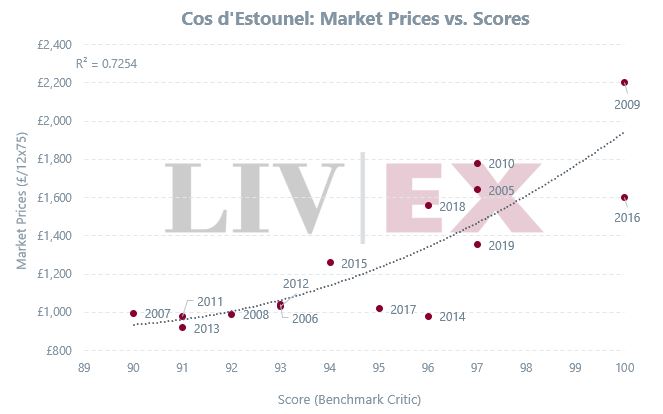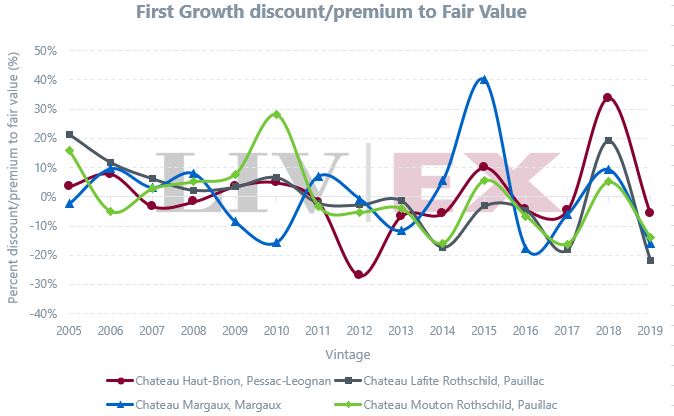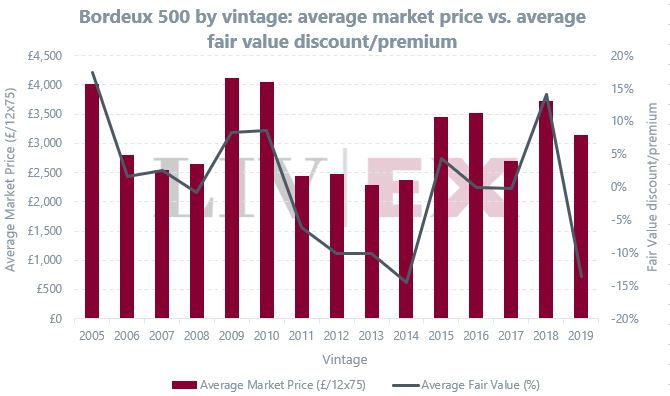Value investing is the art of buying stocks which trade at a discount to their intrinsic value. Berkshire Hathaway Chairman Warren Buffet described it as “finding an outstanding company at a sensible price”. How does this apply to fine wine? Well, not all vintages are alike. Wine critics, however, trusted by those in the market, can offer professional insight into the wines and their future potential. Combining trusted critic scores and Market Prices across a range of vintages allows an observer to begin to build a picture of intrinsic value.
While the trade might follow various critics, a Liv-ex survey amongst its global merchant members revealed that Robert Parker was the most influential Bordeaux wine critic (if not too influential, as suggested by some). Since Parker’s retirement, Neal Martin has taken up the mantel. Thus we introduced the ‘Benchmark Critic’, using Robert Parker’s scores across Bordeaux vintages 2005-2012, and Neal Martin for 2013 onwards.
Liv-ex’s ‘Fair Value’ methodology represents a useful approach to pricing wines. It uses regression analysis to measure the relationship between price and quality (critic score). The R-squared value (0% to 100%) measures how close the data points are to the fitted regression line. In general, the higher the R-squared, the better the regression line (or ‘Fair Value’) fits the data. In statistical terms, the R-squared measures how much of the variation in price can be explained by variations in score.
We hypothesise that, over time, wines will tend toward their ‘Fair Value’ price. The chart below shows this methodology in practice. Cos d’Estournel vintages 2005-2019 are charted with an R-squared of 72.5%. The best fit line represents ‘Fair Value’ with wines each side, above and below their respective fair value. Vintage 2016 is an example of a great wine from a great vintage trading below its Fair Value.

Seen in Chart 2 is the Fair Value analysis of four First Growths – vintages 2005-2019 (x-axis). One can see that after perhaps an early bout of volatility, the First Growths gravitate towards their ‘Fair Value’.
Vintage variation plays a key part in finding value. A problematic growing season, like the damaging frost of 2017, can drag down the allure of the overall vintage. But within the chateau, the First Growths still produced impressive wines – all a single point shy of the 2018s. The Market Prices for the 2017s, however, are much lower thus, all four First Growths are currently priced below ‘Fair Value’ for the 2017 vintage. The 2018 vintage however, after some ambitious pricing, are all above ‘Fair Value’.
The most recent vintage, 2019, which released into a global pandemic at an average discount of 20% on the 2018 release, gave collectors the opportunity to acquire wines below ‘Fair Value’. And so they did.

As you can see, trends emerged across vintages for the First Growths and the data is similar when we look at the broader Bordeaux 500.
‘On’ and ‘Off’ vintages are phrases used throughout the wine world to describe the overall outcome and acclaim of a certain year. Historic ‘On’ vintages include 2005, 2009, 2010, 2015, 2016 and 2019, while ‘Off’ vintages are generally the ones that fall in between. Critical acclaim may still be high within pockets but these ‘Off’ vintages tend not to command a vintage premium. Indeed, more often than not, quite the opposite.
Examining the chart below, it can be seen that ‘On’ vintages command a heavy premium to the market but this does necessarily mean they are overvalued, as they often come with the highest scores.
2016 is a great example. It was heralded as one of the greatest vintages ever produced. Antonio Galloni of Vinous described it as “an epic vintage”. But even with its premium to surrounding vintages, it sits happily on Fair Value (0%).
The 2019 vintage, as already mentioned, looks to present excellent value. Regarded as one of the great vintages of this century (yes, we have had a few!), it is one of the most undervalued on the market. But similarly, we have an “Off” vintage in 2014 offering similar value (and some bottle age to boot).

There is another adage that we can borrow from financial markets. “The market is always right.” This is to say, as with all things, fine wine is worth what consumers and collectors are willing to pay. Bottle design, tariffs, market conditions, and even death (of an esteemed winemaker) will influence the price. But as a rule of thumb, price and quality are the main drivers for Bordeaux. Regression analysis, while not perfect, can be used as a decent measure when seeking out value.





